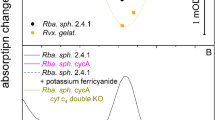Abstract
Flash-induced kinetics of the membrane potential increase related to electron transfer within the cytochrome (cyt) b/c1 complex (Phase III) and that of cyt c1+c2 reduction have been measured as a function of myxothiazol concentration in isolated chromatophores and whole cells of Rhodobacter sphaeroides. Upon addition of nonsaturating concentrations of myxothiazol, kinetics of Phase III display two phases, Phase IIIa and Phase IIIb. The amplitude of Phase IIIa, completed in about 10 ms, is proportional to the fraction of non-inhibited cyt b/c1 complexes, while its half-time is independent of the myxothiazol concentration. A fast cyt c1+c2 reduction phase is correlated to Phase IIIa. These experiments demonstrate that, in a range of time of several ms, diffusion of cyt c2 is restricted to domains formed by a supercomplex including two reaction centers (RCs) and a single cyt b/c1 complex, as proposed by Joliot et al. (Biochim Biophys Acta 975: 336–345, 1989). Phase IIIb, completed in about 100 ms, shows that positive charges or inhibitor molecules are exchanged between supercomplexes in this range of time. These exchanges occur within domains including 2 to 3 supercomplexes, i.e. in membrane domains smaller than a single chromatophore. These conclusions apply to both isolated chromatophores and whole cells.
Similar content being viewed by others
Abbreviations
- cyt:
-
cytochrome
- MOPS:
-
3-(N-morpholino)propane sulfonic acid
- PMS:
-
phenazine methosulfate
- P:
-
primary donor
- Rb. :
-
Rhodobacter
- RC:
-
reaction center
References
Bowyer JR and Crofts AR (1981) On the mechanism of photosynthetic electron transfer in Rhodopseudomonas capsulata and Rhodopseudomonas sphaeroides. Biochim Biophys Acta 636:v218–233
Bowyer JR, Tierny GV and Crofts AR (1979) Secondary electron transfer in chromatophores of Rhodopseudomonas capsulata Ala pho+. FEBS Lett 101: 201–206
Cramer WA and Crofts AR (1982) Electron and proton transport In: Govindjee (ed) Photosynthesis, Vol. 1, Energy Conversion by Plant and Bacteria, pp 387–467. London, Academic Press.
Crofts AR, Meinhardt SW, Jones KR and Snozzi M (1983) The role of the quinone pool in the cyclic electron-transfer chain of Rhodopseudomonas sphaeroides: A modified Q-cycle mechanism. Biochim Biophys Acta 723: 202–218
Dutton PL, Petty KM, Bonner HS and Morse SD (1975) Cytochrome c2 and reaction center of Rhodopseudomonas sphaeroides Ga. Membranes, extinction coefficients, content, half-reduction potentials, kinetics and electric field alterations. Biochim Biophys Acta 387: 536–556
Fernàndez-Velasco J and Crofts AR (1991) Complexes or supercomplexes: inhibitor titrations show that electron transfer in chromatophores from Rhodobacter sphaeroides involves a dimeric UQH2: cyt c2 oxidoreductase, and is delocalized. Biochem Soc Trans 19: 588–593
Joliot P, Béal D and Frilley B (1980) Une nouvelle méthode spectrophotométrique destinée à l'étude des réactions photosynthétiques. J Chim Phys 77: 209–216
Joliot P, Verméglio A. and Joliot A (1989) Evidence for supercomplexes between reaction centers, cytochrome c2 and cytochrome bc1 complex in Rhodobacter sphaeroides whole cells. Biochim Biophys Acta 975: 336–345
Joliot P, Verméglio A and Joliot A (1993) Supramolecular membrane protein assemblies in photosynthesis and respiration. Biochim Biophys Acta 1141: 151–174
Kaminskaya OP, Drachev LA, Konstantinov AA, Semenov AY and Skulachev VP (1986) Electrogenic reduction of the secondary quinone acceptor in chromatophores of Rhodospirillum rubrum. FEBS Lett 202: 224–228
Kaplan S (1983) Biosynthesis of the photosynthetic membrane of Rhodopseudomonas spheroids. J Cell Biochem 22: 15–29
Meinhardt SW and Crofts AR (1982) The site and mechanism of action of myxothiazol as an inhibitor of electron transfer in Rhodopseudomonas sphaeroides. FEBS Lett 149: 217–222
Overfield RE, Wraight CA and Devault D (1979) Microsecond photooxidation kinetics of cytochrome c2 from Rhodopseudomonas sphaeroides. FEBS Lett 105: 137–142
Saphon S, Jackson JB, Lerbs V and Witt HT (1975) The functional unit of electrical events and phosphorylation in chromatophores from Rhodopseudomonas sphaeroides. Biochim Biophys Acta 408: 58–66
Verméglio A, Joliot P and Joliot A (1993) The rate of cytochrome c2 photooxidation reflects the subcellular distribution of reaction centers in Rhodobacter sphaeroides Ga cells. Biochim Biophys Acta 1183: 352–360
Verméglio A, Joliot P and Joliot A (1995) Organization of electron transfer components and supercomplexes. In: Blankenship RE, Madigan MT and Bauer CE (eds) Anoxygenic Photosynthetic Bacteria, pp 279–295. Kluwer Academic Publishers, Dordrecht, The Netherlands
Author information
Authors and Affiliations
Rights and permissions
About this article
Cite this article
Joliot, P., Verméglio, A. & Joliot, A. Supramolecular organization of the photosynthetic chain in chromatophores and cells of Rhodobacter sphaeroides . Photosynth Res 48, 291–299 (1996). https://doi.org/10.1007/BF00041020
Received:
Accepted:
Issue Date:
DOI: https://doi.org/10.1007/BF00041020




